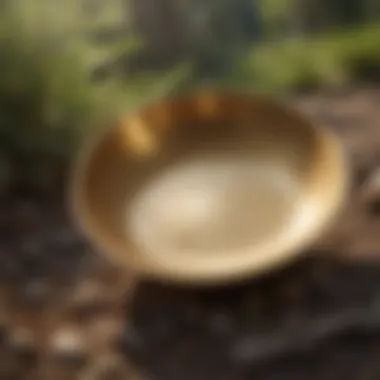Unlock the Secrets: Your Ultimate Gold Prospecting Starter Kit Guide


Introduction
Embarking on a thrilling journey into the world of gold prospecting requires a comprehensive understanding of essential equipment and key techniques. This detailed guide is designed to equip individuals with the knowledge and confidence needed to kickstart their prospecting adventure. From identifying key equipment to mastering techniques, this guide covers everything you need to know to begin your pursuit of gold with efficiency and precision.
Essential Equipment
Before venturing into the exciting realm of gold prospecting, it is imperative to have the right tools at your disposal. Essential equipment includes a gold pan, a classifier, a small shovel or trowel, and a snuffer bottle. These tools play a crucial role in the prospecting process, enabling individuals to effectively sift through sediment and extract gold particles.
Key Techniques
Mastering key techniques is essential for successful gold prospecting. Understanding how to pan for gold, use a classifier to separate materials, and spot potential gold deposits are fundamental skills. Additionally, learning how to read river currents and identify geological indicators can greatly enhance your prospecting efficiency. By honing these techniques, prospectors can increase their chances of discovering valuable gold deposits.
Location Selection
Choosing the right location is paramount in gold prospecting. Opt for areas with a history of gold production, such as rivers and creeks with known gold deposits. Researching geological maps and consulting local mining authorities can provide valuable insights into prime prospecting sites. Moreover, consider factors like accessibility, potential environmental impact, and permission requirements before selecting a location.
Safety Precautions
Safety should always be a top priority when embarking on a gold prospecting journey. Ensure to carry essential safety gear such as sturdy boots, protective gloves, and a first aid kit. Stay informed about any potential hazards in the area, such as wildlife or rough terrain, and always prospect with a friend or let others know your planned whereabouts.
Conclusion
Introduction to Gold Prospecting
Gold prospecting opens the door to an exhilarating journey filled with possibilities and discoveries. It serves as a gateway to uncovering nature's hidden treasures and delving into the timeless allure of gold. Understanding the basics of gold prospecting is key to embarking on this rewarding pursuit. From the historical roots of gold prospecting to the nuanced terminologies that define the craft, laying a solid foundation through knowledge is essential to navigate this intricate world effectively.
Understanding the Basics of Gold Prospecting
History of Gold Prospecting
Exploring the history of gold prospecting unveils a rich tapestry dating back centuries. The legacy of intrepid individuals seeking fortunes in shimmering gold deposits has shaped societies and fueled exploration. Understanding this historical backdrop not only honors the daring spirit of past prospectors but also provides valuable insights into the evolution of techniques and technologies employed today.
Benefits of Gold Prospecting
The benefits of gold pros-pecting extend beyond mere monetary gains. Engaging in this activity offers a profound connection to nature, a chance to hone observational skills, and a gateway to local history and geology. The enriching experience of prospecting fosters patience, perseverance, and an appreciation for the earth's treasures, making it a fulfilling pursuit for enthusiasts seeking more than just gold.
Key Terminologies in Prospecting
Navigating the realm of gold prospecting requires familiarity with specialized terminologies. From 'pay dirt' to 'rocker box' and 'fines,' these terms form the language of prospectors, facilitating effective communication and knowledge exchange within the community. Acquiring fluency in these key terms enhances not only practical prospecting activities but also cultivates a deeper immersion into the culture and traditions of this age-old practice.
Importance of Having the Right Equipment
Selecting the right equipment lays the foundation for successful and enjoyable prospecting expeditions. From the types of essential equipment needed to the art of choosing tools tailored to individual preferences, having the optimal gear boosts efficiency and maximizes chances of striking gold. Additionally, understanding equipment maintenance is crucial for ensuring the longevity and optimal performance of tools, safeguarding investment and streamlining prospecting operations.


Safety Precautions in Gold Prospecting
Prioritizing safety in gold prospecting is non-negotiable. Equipping oneself with proper protective gear, considering environmental implications, and preparing for emergencies are integral facets of responsible prospecting. By fostering a culture of safety consciousness and preparedness, prospectors can safeguard their well-being, minimize environmental impact, and uphold ethical standards in their pursuit of gold.
Building Your Gold Prospecting Starter Kit
In the vast realm of gold prospecting, having a well-equipped starter kit is paramount to your success. A carefully curated collection of tools and gadgets can significantly boost your efficiency and productivity in uncovering precious gold deposits. By selecting the right gear, you not only enhance your chances of striking gold but also ensure a smooth and enjoyable prospecting experience. Your gold prospecting starter kit serves as the foundation of your exploration journey, equipping you with the essentials needed to navigate the world of prospecting with confidence.
Selecting the Right Gold Pan
Types of Gold Pans:
When it comes to gold pans, the variety available caters to different prospecting styles and preferences. From traditional steel pans to modern plastic ones, each type offers distinct advantages based on their design and material. Steel pans, known for their durability, are favored by experienced prospectors for their longevity and ruggedness in challenging terrains. On the other hand, plastic pans are lightweight and easy to use, making them ideal for beginners seeking comfort during prolonged panning sessions. Overall, the choice of gold pan depends on your skill level, prospecting conditions, and personal preference.
Choosing the Ideal Size and Material:
The size and material of your gold pan can significantly impact your prospecting process. Opting for a larger pan allows you to process more material at once, thereby increasing your chances of finding gold. However, smaller pans offer better precision for careful examination of concentrates. When it comes to material, plastic pans are rust-resistant and easier to clean, providing convenience for frequent use. Conversely, steel pans are robust and suitable for rigorous prospecting activities. Selecting the right size and material ensures efficient gold recovery and a comfortable panning experience.
Essential Tools for Prospecting Success
Trowel and Shovel:
The trowel and shovel are indispensable tools for excavation during prospecting expeditions. A sturdy trowel aids in loosening soil and rocks, allowing you to access deeper layers for potential gold deposits. Likewise, a quality shovel facilitates efficient material movement, enabling you to process larger quantities with ease. The combination of these tools enhances your prospecting efficiency, enabling thorough exploration of prospective areas with precision.
Snuffer Bottle and Magnifying Glass:
A snuffer bottle and magnifying glass are essential for fine gold recovery and detailed examination of precious specimens. The snuffer bottle helps in capturing tiny gold flakes and particles, preventing loss during panning and sluicing. Meanwhile, a magnifying glass allows for closer inspection of gold samples, aiding in the identification of valuable nuggets and deposits. These tools play a pivotal role in enhancing your prospecting accuracy and maximizing gold retention.
Gold Classifier and Loupe:
A gold classifier and loupe are crucial accessories for prospectors aiming for refined gold recovery and detailed analysis. The classifier efficiently filters debris and sediment, ensuring that only concentrated material enters your pan or sluice box. On the other hand, a loupe provides magnification for close examination of gold textures, colors, and impurities. Incorporating these tools into your kit enhances your ability to identify and retrieve gold efficiently, elevating your prospecting success rate.
Navigating the World of Prospecting Gadgets
Metal Detectors:
Metal detectors are invaluable gadgets for modern prospectors seeking to uncover buried treasures and hidden gold deposits. These devices use electromagnetic fields to detect metallic objects underground, allowing you to pinpoint potential gold-rich areas with precision. Whether scanning riverbeds or exploring mineshafts, metal detectors offer enhanced efficiency in target identification, streamlining your prospecting efforts. With adjustable sensitivity and discrimination settings, these gadgets cater to prospectors of all skill levels, providing a valuable asset for successful gold hunting.
Sluice Boxes:
Sluice boxes are classic tools in the world of gold prospecting, designed to efficiently separate gold from surrounding materials. These long, narrow channel boxes use flowing water to wash away lighter sediments while trapping heavier gold particles. Their simple yet effective design enables continuous processing of material, maximizing gold recovery rates during sluicing operations. Whether set up along riverbanks or mounted on specialized stands, sluice boxes serve as essential equipment for prospectors aiming to process large volumes of material in search of precious gold.
Gold Trommels:
Gold trommels are versatile gadgets that aid in efficient screening and washing of gold-bearing materials. These rotating drums feature varying screen sizes to classify different-sized particles, allowing for the separation of gold from gravel and debris. With built-in water jets and agitation mechanisms, gold trommels facilitate thorough cleaning of material, ensuring optimal recovery of fine gold particles. Their portability and versatility make them ideal for prospectors exploring diverse terrains and processing various types of deposits, enhancing the overall efficiency and effectiveness of prospecting operations.


Mastering Gold Prospecting Techniques
Gold prospecting involves mastering various techniques essential for successful prospecting. In this section, we delve into the importance of mastering gold prospecting techniques within the broader context of the prospecting journey. By understanding and honing these techniques, individuals can enhance their efficiency and accuracy in identifying and recovering gold.
Panning Like a Pro
Proper Panning Technique
Proper panning technique is a fundamental skill in gold prospecting, crucial for separating gold from sediment effectively. It involves carefully swishing a mixture of sediment and water in a pan to allow heavier materials like gold to settle at the bottom. This technique is favored for its simplicity and effectiveness, making it a popular choice for novice and experienced prospectors alike. However, proper panning technique requires patience and precision to ensure optimal results in gold recovery.
Identifying Gold Traps
Identifying gold traps is another key aspect of successful prospecting. Gold traps are areas where gold is likely to accumulate, such as crevices or bedrock pockets. Understanding how to identify these traps is imperative for maximizing gold recovery. By recognizing the geological indicators that signal potential gold traps, prospectors can target their efforts efficiently, increasing their chances of finding significant gold deposits.
Tips for Efficient Gold Recovery
Efficient gold recovery is paramount in gold prospecting, and implementing certain tips can significantly improve results. These tips may include working in slow and controlled motions while panning, using a classifier to sift through materials, and ensuring proper lighting for better visibility. By incorporating these tactics into prospecting endeavors, individuals can enhance their workflow and recover gold more effectively.
Utilizing Metal Detectors Effectively
Understanding Detector Signals
Metal detectors play a crucial role in modern gold prospecting by detecting metal objects buried in the ground. Understanding detector signals is essential for distinguishing between various materials and identifying potential gold targets. By interpreting these signals accurately, prospectors can save time and effort by focusing on valuable finds, boosting their overall efficiency in the field.
Sweeping Techniques
Sweeping techniques refer to the motion used to scan an area with a metal detector properly. Effective sweeping involves overlapping sweeps in a systematic pattern to ensure thorough coverage of the search area. Proper sweeping techniques minimize the chances of missing valuable targets, increasing the likelihood of making significant gold finds during prospecting expeditions.
Digging and Recovering Targets
Once a metal detector signals a target, prospectors must employ proper digging and recovery techniques to extract the find successfully. Digging tools such as trowels or shovels are used to unearth the target carefully without damaging it. Recovering targets requires delicacy and patience to avoid losing or fragmenting valuable specimens, ensuring a successful prospecting experience.
Maximizing Efficiency with Sluicing and Dredging
Setting Up a Sluice Box
Setting up a sluice box is a common method for efficiently processing large volumes of sediment to extract gold. The sluice box is positioned in a waterway, allowing the continuous flow of water to wash away lighter materials while trapping heavier gold particles in riffles. Properly setting up a sluice box involves achieving the optimal angle and flow rate to maximize gold retention and recovery.
Navigating Dredging Permits
Dredging permits are required for certain prospecting activities that involve the use of suction dredges to extract gold from waterways. Navigating the permit process involves understanding and complying with local regulations and environmental restrictions. By obtaining the necessary permits and adhering to established guidelines, prospectors can legally engage in dredging activities while minimizing environmental impact.
Optimizing Fine Gold Recovery


Fine gold recovery is a meticulous process that necessitates the optimization of equipment and techniques. By using specialized tools such as gold classifiers and properly adjusting water flow rates, prospectors can increase their recovery rates of fine gold particles that would otherwise be easily lost. Optimizing fine gold recovery methods enhances overall prospecting efficiency and the potential for capturing valuable gold deposits.
Exploring Gold Prospecting Locations
In the realm of gold prospecting, exploring the right locations holds paramount importance. Understanding where to search for potential gold deposits can significantly impact the success of your prospecting endeavors. By meticulously researching and identifying promising areas, prospectors can maximize their chances of striking gold. The exploration process involves delving into historical data, geographic features, and geological indicators to pinpoint areas with high gold-bearing potential. This meticulous approach not only enhances the efficiency of prospecting efforts but also saves time and resources in the long run.
Researching Potential Gold Deposits
Online Resources for Prospectors
When it comes to researching potential gold deposits, online resources serve as invaluable tools for modern-day prospectors. These platforms offer a wealth of information, including historical mining data, geological maps, and mineral reports, allowing prospectors to conduct thorough research from the comfort of their homes. Online resources enable prospectors to identify prospective areas, access updated geological surveys, and connect with like-minded individuals in the prospecting community. While these platforms streamline the research process, it's essential for prospectors to verify the credibility of the information obtained and cross-reference multiple sources to ensure accuracy.
Identifying Geological Indicators
Geological indicators play a crucial role in gold prospecting, providing key insights into the presence of gold-bearing deposits. By attentively analyzing rock formations, mineral veins, and structural geology, prospectors can decipher potential gold-rich areas with precision. Identifying geological indicators involves keen observation and a sound understanding of geological processes, allowing prospectors to narrow down their search areas and focus their efforts on locations with high mineralization potential. While geological indicators offer invaluable clues to prospectors, it's imperative to continually update knowledge and skills to adapt to different geological settings and conditions.
Consulting with Local Experts
Engaging with local experts is a strategic move for prospectors seeking to unlock the secrets of potential gold deposits. Local experts possess invaluable knowledge of the area's geology, mining history, and prospecting trends, providing insider insights that can guide prospectors towards promising sites. By consulting with geologists, experienced prospectors, and mining officials, prospectors can gain access to specialized advice and regional expertise that could significantly enhance their prospecting success. Additionally, local experts can offer valuable recommendations on prospecting techniques, equipment selection, and safety considerations, further empowering individuals entering the world of gold prospecting.
Popular Gold Prospecting Sites
California Gold Country
California's Gold Country stands as a legendary destination for gold prospectors, boasting a rich history of gold discoveries dating back to the 1849 Gold Rush. The region's diverse terrain, encompassing rugged mountains, winding rivers, and fertile valleys, offers a myriad of prospecting opportunities for enthusiasts. Prospecting in California Gold Country provides a unique blend of adventure, history, and geological wonders, making it a favored destination for those seeking the thrill of gold discovery. While the area holds substantial potential for gold extraction, prospectors must adhere to strict regulations and environmental guidelines to preserve the region's natural integrity and historical significance.
Yukon Territory, Canada
Yukon Territory in Canada holds a storied reputation as a prime location for gold prospecting, characterized by vast wilderness, pristine rivers, and untapped mineral riches. The territory's remote landscapes and untouched natural beauty attract prospectors from around the globe in search of gold treasures. Yukon's gold-bearing creeks, creeks, and rivers offer ample opportunities for both recreational and commercial prospecting activities, with the promise of uncovering significant gold deposits. While prospecting in Yukon presents unique challenges due to its remote location and harsh climate, the potential rewards of striking gold in this rugged territory continue to captivate the hearts of prospecting enthusiasts.
Victoria, Australia
Victoria, Australia, holds a special place in the world of gold prospecting, revered for its historic gold rushes that transformed the region into a thriving hub of mining activity. The state's goldfields, including renowned sites like Ballarat and Bendigo, have yielded substantial quantities of gold over the years, attracting prospectors with their golden heritage and hidden riches. Victoria's varied landscapes, ranging from rolling plains to rocky outcrops, offer diverse prospecting opportunities for beginners and seasoned veterans alike. While prospecting in Victoria promises exciting discoveries and memorable experiences, prospectors must adhere to strict regulations, obtain the necessary permits, and respect the landowner rights to ensure responsible and sustainable prospecting practices.
Legal Considerations and Permitting
Navigating the legal landscape of gold prospecting is essential for ensuring compliance with regulatory requirements and fostering responsible prospecting practices. Understanding mining laws, securing permits and licenses, and respecting landowner rights are crucial aspects that prospectors must prioritize to conduct their activities ethically and legally. By familiarizing themselves with the applicable regulations, prospectors can mitigate potential risks, protect natural habitats, and uphold the integrity of the prospecting community.
Understanding Mining Laws
A foundational pillar of responsible prospecting revolves around a profound understanding of mining laws and regulations governing the extraction of minerals. Mining laws outline the rights, obligations, and restrictions associated with prospecting and mining activities, ensuring that prospectors operate within the boundaries of the law. Whether it involves claim staking, mineral rights, or environmental protection, adhering to mining laws is non-negotiable for individuals entering the world of gold prospecting. By abiding by these laws, prospectors contribute to sustainable resource management and uphold the ethical standards of the mining industry.
Securing Permits and Licenses
Securing the requisite permits and licenses is a crucial step in legalizing prospecting activities and gaining authorization to explore designated areas for mineral deposits. Permits vary based on the location and scale of prospecting operations, with regulations stipulating the conditions under which prospectors can conduct their activities. Obtaining permits ensures that prospectors operate with official approval, reducing the risk of legal violations and protecting the integrity of the prospecting sites. While the permitting process may involve paperwork and procedural formalities, it is an essential aspect of responsible prospecting that fosters transparency, accountability, and environmental stewardship.
Respecting Landowner Rights
Respecting landowner rights is a fundamental principle that underpins ethical prospecting practices and promotes positive relationships between prospectors and property owners. Whether prospecting on public lands or private properties, it is imperative for prospectors to obtain consent from landowners and adhere to established protocols for access and exploration. By honoring landowner rights, prospectors demonstrate respect for property boundaries, natural resources, and local communities, fostering a harmonious coexistence between prospecting activities and landownership. Additionally, building constructive partnerships with landowners can create opportunities for collaborative prospecting ventures, knowledge-sharing, and community engagement, enriching the prospecting experience and promoting sustainable practices in the field.
This detailed guide encompasses the intricate facets of exploring gold prospecting locations, from conducting thorough research to understanding legal requirements and ethical considerations. By delving into the geographic, geological, and regulatory aspects of gold prospecting, individuals can embark on their prospecting journeys equipped with the knowledge and insight needed to navigate the fascinating world of gold discovery.







